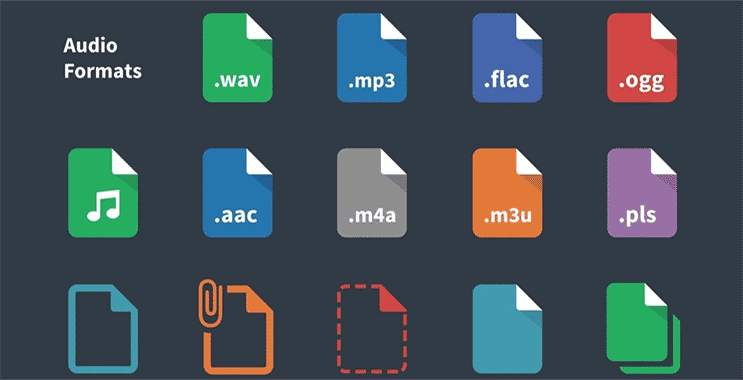Best Audio Format for Podcast: What Every Creators Need to Know
As a podcaster, you must examine hundreds of factors before publishing a new episode to your feed.
However, don't overlook the audio format for podcast, since it might influence what your listeners end up hearing.
The best format for podcast audio may help ensure that your audio sounds well and that the content is compatible with the platforms you use.
Check out the guide below!
.jpg)
Best audio file format for podcast
Best Audio Formats for Podcasts
MP4 is the file format best suited for podcasting. MP4 is a multimedia container format that may store subtitles and images in addition to digital audio and video streams.
It is based on Apple's QuickTime container format and was adopted as an international standard in the year 2000.
However, many people still stick with MP3, and lossless audio like FLAC to maintain quality.
But take your time with the options. Find the audio file format that best suits your needs, whether you're just listening or mixing and mastering.
MP3 (MPEG Layer 3)
This audio file is one of the common audio file formats that are widely used and supported by almost portable audio players, Internet-connected TVs, and software-based media players.
Special information called id3 Tags can be stored in the audio file using this format.
Artist information, lyrics, and album artwork are all included in these specific tags.
It is the most optimal format to employ in almost all circumstances because it is widely acknowledged and robust enough to contain media content.
.jpg)
MP3 audio file format
Patent holders have refused to charge license fees for MP3 decoders that are free and open-source. Furthermore, users of free and open-source MP3 encoders are exempt from paying patent fees.
File extensions: .mp3
-
Pros: Universal and easy to use.
-
Cons: In terms of compression and quality, it falls short of other audio formats.
M4A / AAC
The AAC format (M4A or ACC file extension) was created to succeed the MP3 format and offers somewhat reduced file sizes and improved audio quality.
ITunes more often uses the AAC codec for selling audio from the iTunes music store since it enables Digital Rights Management (DRM).
.jpg)
M4A audio file format
The AAC format is being adopted by many brands as an audio format for podcasts and it may replace the MP3 format in the coming years.
It is important to note that there are many devices that will not play an M4A file, such as most Blackberry smartphones.
File extensions: .m4a, .aac, .mp4, .m4p, .m4r, 3gp
-
Pros: Increasingly used, small file size, good quality
-
Cons: Low compatibility
Other Podcast Audio Format
Below is a list of the most common audio formats with a brief description and note on usage. All of the following audio file formats offer high-quality sound in a compressed format:
WAV
.jpg)
WAV audio file format
WAV files are unprocessed audio files that contain all of the original recordings in their entirety. This implies that nothing is compressed, which is perfect for editing; the only drawback is that the files are enormous.
Regarding audio format for podcast, WAV should be taken into consideration. It has a quality which is as good as that of a CD.
WMA
.jpg)
WMA audio file format
WMA is a Windows-only format. If you're using a Mac, Linux, or another operating system, WMA will only work if you jump through a few hoops. Unless you have a specific use case in mind, don't export your podcast as a WMA file.
► Read more: Types of video formats
FLAC
FLAC is comparable to MP3, but it is lossless, meaning it compresses audio without sacrificing quality (plus, the overall size is reduced).
Without question, this is the most effective way to control audio. However, the only drawback is that it is less widely used than MP3 or WMA right now.
.jpg)
FLAC audio file format
AIFF
Another raw audio file format is AIFF, or Audio Interface File Format, which Apple developed in the late 1980s.
Like WAVs, AIFFs need a lot of storage space and similarly hold lossless, uncompressed sound.
.jpg)
AIFF audio file format
The key distinction is that AIFFs feature ID3 tags, which are metadata containers that store information such as album titles, track or song names, genres, cover art, and more.
Importantly, AIFFs do not have timecodes; hence, they may be more difficult to mix or edit.
What Are the Limits?
Most people listen to podcasts using the Apple Podcasts app. Apple has introduced a file restriction of 150MB for all cellular downloads (including ebooks, apps, and videos).
When your listeners try to play your episode, they are met with a very unhelpful message—"episode unavailable"—which is a disappointing experience to say the least.
.jpg)
Apple has introduced a file restriction of 150MB
To reduce file size, you can utilize audio editing tools to export the episode audio file at a reduced bitrate. Choose to export as 128kbps MP3.
It keeps the file size optimal enough for streaming while keeping audio fidelity. Additionally, this format is supported by all major podcast platforms and networks.
Unless you want to go through the extra work of converting the audio before posting it to YouTube, go with MP3.
• Use a bitrate between 64-192 kbps.
• Set your loudness between -16db LUFS and -19db LUFS.
• Be consistent with all file specs.
• Add ID3v2 tags to your first segment.
• Limit ID3 tag size to 300kb with 800x800 pixels max for the artwork.
Conclusion
When it comes to the best audio format for podcast, there is no clear winner. To retain quality, most people still use MP3, while some choose lossless audio, such as FLAC. Which one you choose is entirely up to you.



0 Comments
Leave a Comment
Your email address will not be published. Required fields are marked *